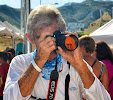 |
Minerva’s response was immediate. "No problem, honey, I'll
be there," she replied in her usual cheerful fashion.
|
Some
International Game Fish Association (IGFA) World Records are kinda’ by accident
and even taken for granted, especially the first one. But, there are those who
catch record fever after accidently catching that first one…and for others, it
simply becomes a lifelong pursuit. And
for many others, they become World Record “chasers” the moment they become IGFA
members.
The
process itself seems to be very straight forward. Catch a contender, weigh it, measure it,
photograph it, fill out the required forms and submit them to IGFA…with many
individuals involved in the procedure.
For the past
twenty years, I have had the honor of serving as an IGFA Representative-at-Large
in Baja, one of approximately 300 men and women in 90 countries who act as ambassadors of IGFA - a
liaison between the angling interests in their areas across the globe and IGFA
Headquarters in the United States.
Guy Yocom's impressive
catch aboard his boat El Suertudo last week was an example
of what occurs after the catch, both behind the scenes and surrounding the
event.
On Tuesday at 2:04 p.m., Captain
Billy Miagawa, Jr. notified me that Greg Di Stefano, Captain of the El Suertudo, had reported that he was headed for Cabo San
Lucas to weigh in a large yellowfin tuna caught on IGFA regulation tackle
with an ETA some time Wednesday morning.
Coincidently, I had been on-hand
for the last yellowfin all-tackle IGFA world record weigh-in when Mike
Livingston's 405.2 was weighed in at San Diego, Calif., ultimately defeating a
record that had stood for 33 years. I briefly considered flying down for the
weigh-in, but airline schedules eliminated that option.
Instead, I alerted Michael Farrior,
IGFA Trustee here in the U.S. and contacted Minerva Saenz, a long-time IGFA
Representative and owner and operator of Minerva's Baja Tackle and Sportfishing
Charters in Cabo San Lucas informing both of the impending arrival of the potential
world record aboard El Suertudo.
Minerva’s response was immediate. "No
problem, honey, I'll be there," she replied in her usual cheerful fashion.
"I will not only arrange for a local photographer and make sure he takes
all the photos needed, but I will also assist them with the application form
and measurements."
Since the yellowfin tuna had been
caught with a Mustad hook there was a possibility that the catch might be
eligible for the $1,000,000 prize offered by Mustad. Our next step was to notify
Jeff Pierce, Mustad's sales manager.
By Wednesday morning, when the behemoth fish was brought to the
scale, the rumors flying around the Marina became a reality. Clearly the word
was out and a large crowd gathered with Minerva and photographer, Mario Bañaga,
Jr. Minerva supervised the weigh-in and
assisted with paperwork while Mario took the photos.
With the IGFA world record on the line, Captain Greg Di Stefano
confirmed that prior to the trip they had been in contact with Jack Vitek, IGFA
World Records’ Coordinator, sending him samples of line that would be used
during the trip for testing. For that same reason it was decided to weigh the
fish with two different scales and then deliver them to Giesela Muccillo at International
Weighing Systems in San Diego for testing. Giesela indicated that the testing
would be complete sometime during the week of the 24th when the
weight would be confirmed.
Meanwhile photos of the fish taken with cell phone cameras began
appearing across the Internet. One of the first places one appeared with a
brief description was Brandon Hayward's blog on WON.com, followed immediately
by others on Facebook…all with a slightly different versions.
Boat Captain, angler and crew were barraged by individuals on
the dock, as well as by telephone, with questions seeking information that
could be reported. By nightfall a Google search yielded 67 listings about the
catch.
Once
the paperwork is completed it will then be delivered to IGFA for review by Jack
Vitek, who states: "For record approval, we have to wait a minimum of 90
days from the catch date for international claims. That being said, by the time
the application is in our hands…it takes approximately 2 to 3 months, depending
on the travel schedule of the President and Conservation Director as they also
review the applications.”
According to Vitek there are approximately 750 IGFA World Record applications
processed a year, requiring a remarkable amount of effort of what could be
considered a village of IGFA staff, volunteers and many others who become involved
for one reason or another ensuring that each and every World Record application
is evaluated and judged fairly.




